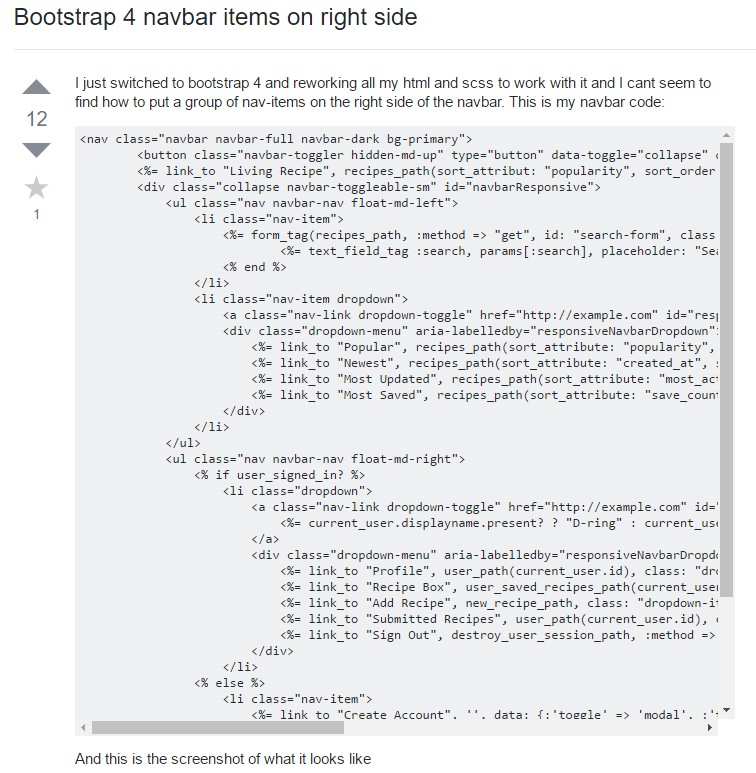Bootstrap Menu Styles
Intro
Even the simplest, not talking about the more difficult pages do desire several type of an index for the visitors to conveniently get around and identify what exactly they are actually looking out for in the first handful of seconds avter their coming over the page. We should really always have in head a user might be in a hurry, looking numerous pages briefly scrolling over them searching for an item or else decide. In these cases the understandable and effectively specified navigational selection might possibly bring in the contrast when comparing a single latest customer and the page being actually clicked away. So the design and behavior of the webpage site navigation are important in fact. Furthermore our websites get more and more viewed from mobiles so not owning a page and a navigating in special behaving on smaller sreens practically matches not possessing a page at all and even a whole lot worse.
The good thing is the new 4th edition of the Bootstrap framework offers us with a effective device to take care of the situation-- the so called navbar component or the menu bar we got used noticing on the high point of many webpages. It is really a quick yet powerful instrument for wrapping our brand's identity information, the webpages design as well as a search form or a couple of call to action buttons. Let us see how this whole thing gets handled inside Bootstrap 4.
The best way to use the Bootstrap Menu Design:
First and foremost we require a
<nav>.navbar.navbar-light.bg-fadedbg-inverse.navbar-inverseYou are able to likewise apply some of the contextual classes such as
.bg-primary.bg-warningAnother bright new element presented in the alpha 6 of Bootstrap 4 system is you need to in addition assign the breakpoint at which the navbar must collapse in order to get exhibited once the menu button gets pressed. To perform this put in a
.navbar-toggleable- ~the desired viewport size ~<nav>Next action
Next we ought to set up the so called Menu switch that will show in the place of the collapsed Bootstrap Menu jQuery and the visitors are going to use to bring it back on. To execute this set up a
<button>.navbar-togglerdata-toggle =“collapse”data-target =“ ~ the ID of the collapse element we will create below ~ ”.navbar-toggler-rightPromoted material
Navbars arrived using integrated service for a fistful of sub-components. Choose from the following as demanded :
.navbar-brand.navbar-nav.navbar-toggler.form-inline.navbar-text.collapse.navbar-collapseHere is actually an example of every the sub-components involved in a responsive light-themed navbar that immediately collapses at the
md<nav class="navbar navbar-toggleable-md navbar-light bg-faded">
<button class="navbar-toggler navbar-toggler-right" type="button" data-toggle="collapse" data-target="#navbarSupportedContent" aria-controls="navbarSupportedContent" aria-expanded="false" aria-label="Toggle navigation">
<span class="navbar-toggler-icon"></span>
</button>
<a class="navbar-brand" href="#">Navbar</a>
<div class="collapse navbar-collapse" id="navbarSupportedContent">
<ul class="navbar-nav mr-auto">
<li class="nav-item active">
<a class="nav-link" href="#">Home <span class="sr-only">(current)</span></a>
</li>
<li class="nav-item">
<a class="nav-link" href="#">Link</a>
</li>
<li class="nav-item">
<a class="nav-link disabled" href="#">Disabled</a>
</li>
</ul>
<form class="form-inline my-2 my-lg-0">
<input class="form-control mr-sm-2" type="text" placeholder="Search">
<button class="btn btn-outline-success my-2 my-sm-0" type="submit">Search</button>
</form>
</div>
</nav>Brand
The
.navbar-brand
<!-- As a link -->
<nav class="navbar navbar-light bg-faded">
<a class="navbar-brand" href="#">Navbar</a>
</nav>
<!-- As a heading -->
<nav class="navbar navbar-light bg-faded">
<h1 class="navbar-brand mb-0">Navbar</h1>
</nav>Nav
Navbar navigation links build on Bootstrap
.navActive states-- with
.active.nav-links.nav-items
<nav class="navbar navbar-toggleable-md navbar-light bg-faded">
<button class="navbar-toggler navbar-toggler-right" type="button" data-toggle="collapse" data-target="#navbarNav" aria-controls="navbarNav" aria-expanded="false" aria-label="Toggle navigation">
<span class="navbar-toggler-icon"></span>
</button>
<a class="navbar-brand" href="#">Navbar</a>
<div class="collapse navbar-collapse" id="navbarNav">
<ul class="navbar-nav">
<li class="nav-item active">
<a class="nav-link" href="#">Home <span class="sr-only">(current)</span></a>
</li>
<li class="nav-item">
<a class="nav-link" href="#">Features</a>
</li>
<li class="nav-item">
<a class="nav-link" href="#">Pricing</a>
</li>
<li class="nav-item">
<a class="nav-link disabled" href="#">Disabled</a>
</li>
</ul>
</div>
</nav>Forms
Set various form controls and elements within a navbar by using
.form-inline
<nav class="navbar navbar-light bg-faded">
<form class="form-inline">
<input class="form-control mr-sm-2" type="text" placeholder="Search">
<button class="btn btn-outline-success my-2 my-sm-0" type="submit">Search</button>
</form>
</nav>Text
Navbars may likely contain pieces of text with the aid of
.navbar-text
<nav class="navbar navbar-light bg-faded">
<span class="navbar-text">
Navbar text with an inline element
</span>
</nav>Yet another element
Yet another brilliant new capability-- in the
.navbar-toggler<span>.navbar-toggler-icon.navbar-brandNext we have to establish the container for our menu-- it will extend it to a bar along with inline items over the specified breakpoint and collapse it in a mobile view below it. To carry out this generate an element with the classes
.collapse.navbar-collapse.navbar-toggler.collapseFinishing aspect
And finally it's time for the real navigation menu-- wrap it in an
<ul>.navbar-nav.nav<li>.nav-item.nav-linkConclusions
So generally this is certainly the structure a navigational Bootstrap Menu Builder in Bootstrap 4 should carry -- it is actually quite useful and intuitive -- now the only thing that's left for you is thinking out the appropriate system and attractive captions for your web content.
Look at a number of video short training about Bootstrap Menu
Related topics:
Bootstrap menu formal information

Mobirise Bootstrap menu

Bootstrap Menu on the right side

